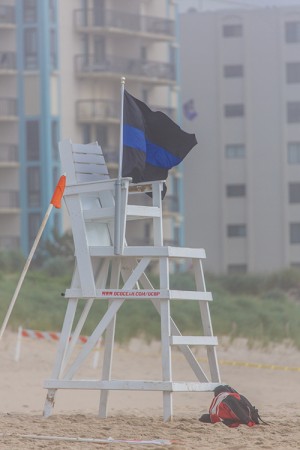
OCEAN CITY — Nearly 18 months after the fatal plane crash off Ocean City, the National Transportation Safety Board (NTSB) on Thursday released its final probable cause report on the incident, pointing to the pilot’s failure to terminate an intentional aerobatic removal prior to hitting the water along with a loss of situation awareness.
Around 3:45 p.m. on June 30, 2013, a Nanchang CJ-6A aircraft, piloted by veteran OCPD officer Tom Geoghegan, Jr., 43, of Ocean City, and his passenger and fellow OCPD officer Joshua Addickes, 27, of Berlin, took off from the Ocean City Municipal Airport in West Ocean City. The plane moved up along the coast until about 4 p.m.
According to witnesses at the scene, the plane appeared to go into a downward spiral in the area of 130th Street and crashed into the ocean on its belly, sinking immediately. The crash was witnessed by hundreds on the beach on a crowded Sunday afternoon in late June. According to witnesses, the plane was flying at a high altitude before moving into some sort of aerobatic maneuver. According to the NTSB’s probable cause report released on Thursday, that aerobatic maneuver was the cause of the fatal crash that claimed the lives of the two officers.
“The National Transportation Safety Board determines the probable cause of this accident to be the pilot’s failure to terminate the intentional aerobatic spin at an altitude adequate to prevent impacting the water,” the report reads. “Contributing to the accident was the pilot’s loss of situational awareness due to target fixation during the prolonged aerobatic maneuver.”
For the last 18 months, NTSB investigators pored over witness testimony, conducted site visits and reviewed the plane’s wreckage to reach their final conclusions on the cause of the accident. According to the report released yesterday, witness accounts and on-board video recording of the accident flight revealed the pilot initiated and performed a series of aerobatic maneuvers with the airplane before initiating a stall, rolling the airplane inverted and entering a steady-state spin into water contact.
“The airplane completed 22 revolutions in the spin, with the engine running smoothly and the stick held fully aft,” the report reads. “Examination of the wreckage revealed no evidence of any pre-impact mechanical anomaly. Review of the pilot’s flight records revealed no evidence of formal aerobatic training. However, the records indicated that he had conducted aerobatic maneuvers, including, on at least one occasion, a flat spin.”
According to the NTSB report, the on-board video recordings showed no signs of pilot distress or incapacitation and indicated the pilot was actively engaged in controlling the airplane and was providing control inputs to maintain the spin to impact. It’s also important to note the pilot’s toxicology report included negative tests for drugs, alcohol or carbon monoxide. There was no evidence of any distracting event or of the pilot attempting to diagnose, troubleshoot or respond to a perceived in-flight control, system or engine anomaly.
“There were multiple cues available to the pilot that the maneuver should be terminated, including an increasing ground presence or perspective from the out-of-window view and the rapidly decreasing altitude indicated on the altimeter in the panel,” the report reads. “However, the pilot failed to terminate the maneuver at an altitude adequate to prevent impacting the water. Therefore, it is most likely that the pilot lost situational awareness during the aerobatic maneuver and prolonged spin and did not recover from the spin before impact. The circumstances of this accident are consistent with the loss of situational awareness due to target fixation. The pilot appears to have focused on the performance or sustainment of the spin maneuver and therefor misjudged or lost awareness of his exit altitude.”
